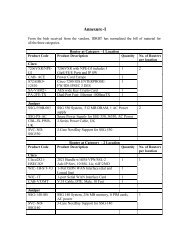New method for feature extraction based on fractal behavior - IDRBT
New method for feature extraction based on fractal behavior - IDRBT
New method for feature extraction based on fractal behavior - IDRBT
You also want an ePaper? Increase the reach of your titles
YUMPU automatically turns print PDFs into web optimized ePapers that Google loves.
1074 Y.Y. Tang et al. / Pattern Recogniti<strong>on</strong> 35 (2002) 1071–1081<br />
The image pixels (m; n) with distance less than<br />
<strong>on</strong>e from (i; j) are taken to be the four immediate<br />
neighbors of (i; j). Similar expressi<strong>on</strong>s exist<br />
when the eight-neighborhood is desired. A point<br />
f(x; y) will be included in the blanket <str<strong>on</strong>g>for</str<strong>on</strong>g> when<br />
b (x; y) ¡f(x; y) ¡u (x; y). The blanket deniti<strong>on</strong><br />
uses the fact that the blanket of the surface <str<strong>on</strong>g>for</str<strong>on</strong>g><br />
radius includes all the points of the blanket <str<strong>on</strong>g>for</str<strong>on</strong>g> radius<br />
−1, together with all the points within radius<br />
1 from the surfaces of that blanket. Eq. (7) ensures<br />
that the new upper surface u is higher by at least<br />
1 from u −1 , andalso at a distance at least 1 from<br />
u −1 in the horiz<strong>on</strong>tal andvertical directi<strong>on</strong>s.<br />
The volume Vol of the blanket is computedfrom<br />
u and b :<br />
Vol = ∑ (u (i; j) − b (i; j)): (9)<br />
i;j<br />
As the volume Vol of the blanket is measuredwith<br />
radius , the area of a <strong>fractal</strong> surface can be deduced<br />
as<br />
A = Vol <br />
2<br />
or<br />
A = Vol − Vol −1<br />
: (10)<br />
2<br />
• Let A() be the area of the surface of the blanket.<br />
Based<strong>on</strong> the Minkowski dimensi<strong>on</strong>, we have<br />
A() ≈ 2−D ; if is suciently small; (11)<br />
where denotes a c<strong>on</strong>stant and D stands <str<strong>on</strong>g>for</str<strong>on</strong>g> the <strong>fractal</strong><br />
dimensi<strong>on</strong> of the image.<br />
Since the dimensi<strong>on</strong> can be regarded as a slope <strong>on</strong><br />
a log–log scale, <strong>on</strong>ly two points are needed to get<br />
the dimensi<strong>on</strong>. We use two values of to compute<br />
the <strong>fractal</strong> dimensi<strong>on</strong>, namely, we take = 1 and 2 ,<br />
then A 1 ≈ 2−D<br />
1<br />
and A 2 ≈ 2−D<br />
2<br />
. Thus, we have<br />
A 1 =A 2 ≈ 2−D<br />
1<br />
= 2−D<br />
2<br />
.<br />
Taking the logarithm of both sides yields<br />
2 − D ≈ log 2 A 1<br />
− log 2 A 2<br />
log 2 1 − log 2 2<br />
;<br />
D ≈ 2 − log 2 A 1<br />
− log 2 A 2<br />
: (12)<br />
log 2 1 − log 2 2<br />
It is usedto approximate the <strong>fractal</strong> dimensi<strong>on</strong> of the<br />
signature images, i.e.,<br />
D ≈ 2 − log 2 A() if is suciently small: (13)<br />
log 2 <br />
We call D as modied <strong>fractal</strong> signature of set F. It<br />
will be used to distinguish the dierent handwritten<br />
signatures.<br />
Several points are worth noting:<br />
1. Why do the dierent document images have dierent<br />
<strong>fractal</strong> dimensi<strong>on</strong>s? The essential distincti<strong>on</strong> of<br />
handwritten signature images is their values of A().<br />
2. The value of A() depends <strong>on</strong> the volume Vol 3 (F )<br />
of thickenedblanket F <strong>on</strong>ly.<br />
3. In summary, they can be representedas<br />
D ⇔ A() ⇔ Vol 3 (F ):<br />
C<strong>on</strong>sequently, in this paper, the volume Vol 3 (F )ofthe<br />
thickenedblanket F is applied to identify dierent handwritten<br />
signature, insteadof using the <strong>fractal</strong> dimensi<strong>on</strong>.<br />
We call such technique of approximating the <strong>fractal</strong> dimensi<strong>on</strong><br />
“Modied Fractal Signature”.<br />
3. Applicati<strong>on</strong>s<br />
From the specic point of view of shape characterizati<strong>on</strong><br />
of patterns the main aim of the <strong>fractal</strong> approach is to<br />
nd a “measure” to distinguish between curves with different,<br />
often very complicated, c<strong>on</strong>tours. The main idea<br />
is to describe the complexity of the curve through a new<br />
parameter, the <strong>fractal</strong> dimensi<strong>on</strong>, so as to ll in the gap<br />
between <strong>on</strong>e- andtwo-dimensi<strong>on</strong>al objects (<str<strong>on</strong>g>for</str<strong>on</strong>g> objects<br />
<strong>on</strong> a plane). Two applicati<strong>on</strong>s of the <strong>fractal</strong> theory are<br />
presentedin this secti<strong>on</strong>, namely: (1) the <strong>fractal</strong> technique<br />
is usedto extract the <str<strong>on</strong>g>feature</str<strong>on</strong>g>s <str<strong>on</strong>g>for</str<strong>on</strong>g> two-dimensi<strong>on</strong>al<br />
objects; (2) the <strong>fractal</strong> signature is employedto identify<br />
dierent handwritten signatures.<br />
3.1. Applicati<strong>on</strong> of <strong>fractal</strong> technique <str<strong>on</strong>g>for</str<strong>on</strong>g> <str<strong>on</strong>g>feature</str<strong>on</strong>g><br />
<str<strong>on</strong>g>extracti<strong>on</strong></str<strong>on</strong>g><br />
Feature <str<strong>on</strong>g>extracti<strong>on</strong></str<strong>on</strong>g> is a crucial step in pattern recogniti<strong>on</strong>.<br />
It is resp<strong>on</strong>sible <str<strong>on</strong>g>for</str<strong>on</strong>g> measuring the <str<strong>on</strong>g>feature</str<strong>on</strong>g>s of the<br />
objects in an image. Pattern recogniti<strong>on</strong> requires the <str<strong>on</strong>g>extracti<strong>on</strong></str<strong>on</strong>g><br />
of <str<strong>on</strong>g>feature</str<strong>on</strong>g>s from the regi<strong>on</strong>s of an image, andthe<br />
processing of these <str<strong>on</strong>g>feature</str<strong>on</strong>g>s with a pattern classicati<strong>on</strong><br />
technique. We employeda central projecti<strong>on</strong> <str<strong>on</strong>g>method</str<strong>on</strong>g><br />
to reduce the problem of two-dimensi<strong>on</strong>al patterns into<br />
that of <strong>on</strong>e-dimensi<strong>on</strong>al <strong>on</strong>es, and thereafter, utilize<br />
the well-established<strong>on</strong>e-dimensi<strong>on</strong>al wavelet trans<str<strong>on</strong>g>for</str<strong>on</strong>g>m<br />
coupledwith <strong>fractal</strong> theory to extract the <strong>on</strong>e-dimensi<strong>on</strong>al<br />
pattern’s <str<strong>on</strong>g>feature</str<strong>on</strong>g> vectors <str<strong>on</strong>g>for</str<strong>on</strong>g> the purpose of pattern<br />
recogniti<strong>on</strong>. The key steps of the experimental procedure<br />
c<strong>on</strong>sist of the following:<br />
Step 1: Central projecti<strong>on</strong> of two-dimensi<strong>on</strong>al<br />
patterns: We denote each of the two-dimensi<strong>on</strong>al patterns<br />
in questi<strong>on</strong> by p(x; y). Thus, the central projecti<strong>on</strong><br />
of p(x; y) can be expressedas follows:<br />
f(x k )=<br />
M∑<br />
p(x k cos i ;x k sin i ): (14)<br />
i=0<br />
Step 2: Wavelet trans<str<strong>on</strong>g>for</str<strong>on</strong>g>mati<strong>on</strong> of the <strong>on</strong>e-dimensi<strong>on</strong>al<br />
patterns: Let f(x k )=c j;k , where k =0; 1;:::;2N −1 and<br />
V 0 = {c j;0 ;c j;1 ;:::;c j;2N−1 }:

















